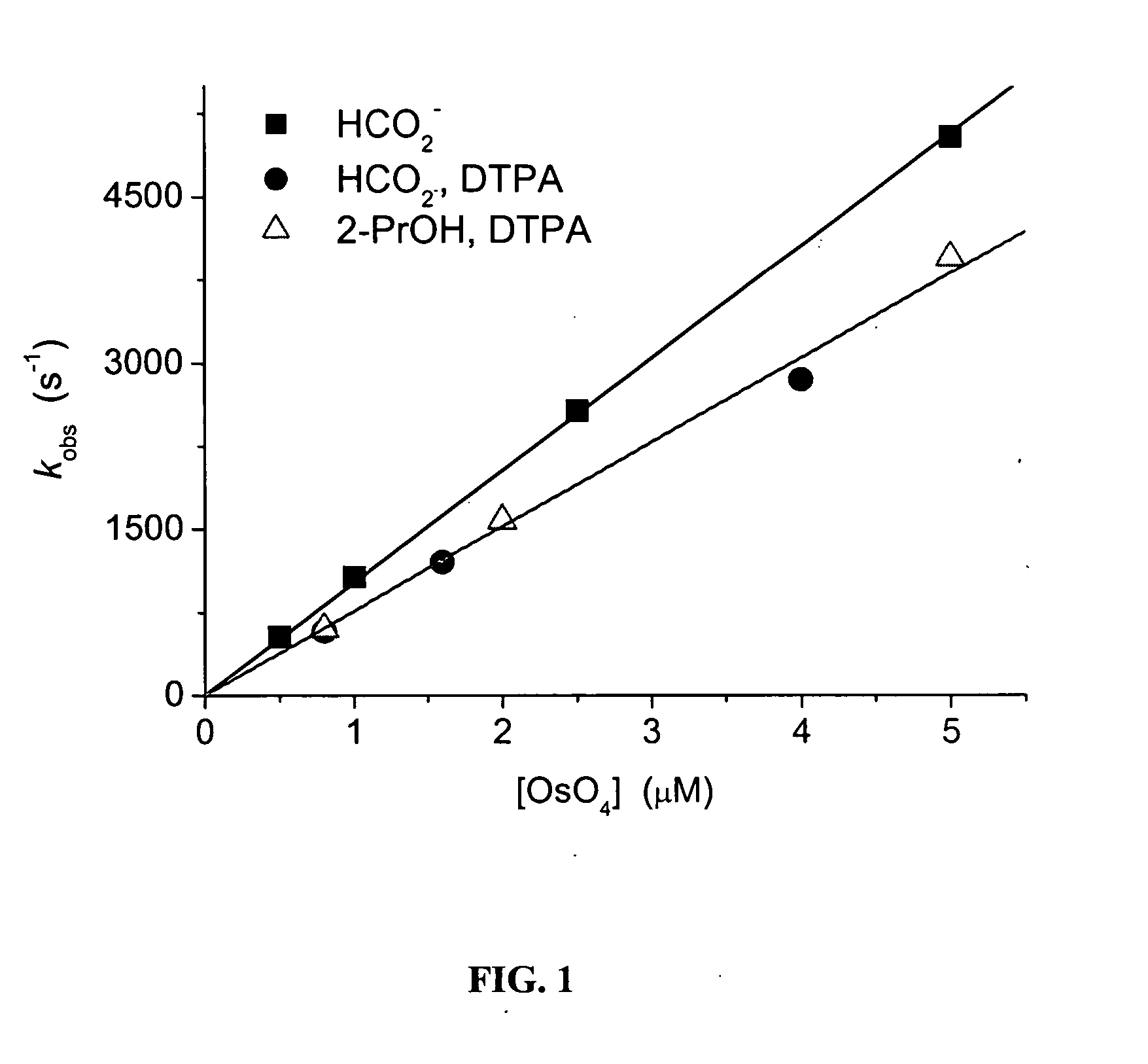Osmium compounds for reduction of adverse inflammation
a technology of osmium compounds and adverse inflammation, applied in the field of medical devices, can solve the problems of reducing the flux of nutrients and/or osub>2 /sub, unwanted change of the concentration of an analyte measured by an implanted sensor or monitor, and failure of the transplanted organ, so as to achieve slowed or avoided the effect of amplified cell killing process
- Summary
- Abstract
- Description
- Claims
- Application Information
AI Technical Summary
Benefits of technology
Problems solved by technology
Method used
Image
Examples
example 1
Os Catalysis, Particularly Os (VIII / VI) Catalysis, of Superoxide Dismutation
Materials and Methods. All chemicals were of analytical grade and were used as received. OsO4 (4 wt. % solution in water) was purchased from Aldrich (Milwaukee, Wis.), and was freshly diluted before use. K2OsCl6.2H2O Cl6 and OsCl3.6H2O were purchased from Alfa Aesar (Ward Hill, Mass.). Catalase (2 mg / ml, about 130,000 u / ml) was obtained from Boehringer (Mannheim, Germany). Bovine serum albumin (BSA) was purchased from Sigma (St. Louis, Mo.). Peroxynitrite was synthesized, as described elsewhere in detail, by reacting nitrite with acidified H2O2 in a quenched-flow system having a computerized syringe pump (WPI Model SP 230IW from World Precision Instruments (Sarasota, Fla.)). 0.63 M nitrite was mixed with 0.60 M H2O2 in 0.70 M HClO4, and the mixture was quenched with 3 M NaOH at room temperature. The stock solution contained 0.11 M peroxynitrite, with about 3% residual H2O2 and 12% residual nitrite. The yie...
example 2
Catalysis of the Decomposition of Carbonate Radical Anion
Materials. Poly-4-vinylpyridine N-oxide (4-PVPNO), ˜200 kD solid and Poly-2-vinylpyridine N-oxide (2-PVPNO), ˜300 kD solid were purchased from Polysciences, Warrington, Pa. The lower molecular weight, 4-PVPNO, Reilline™ 4140 (40% aqueous solution), was purchased from Reilly Industries, Indianapolis, Ind. 4-picoline N-oxide (98%) was purchased from Sigma-Aldrich, St. Louis, Mo.
Methods. Pulse radiolysis experiments were carried out using a 5-MeV Varian 7715 linear accelerator (0.05-1.5 μs electron pulses, 200 mA current). All measurements were performed at room temperature in a 2-cm spectrosil cell, with three light passes (optical path length 6.1 cm). The formation and decay kinetics of the CO3− radical were tracked by measuring its absorption at 600 nm using ε600=1860 M−1cm−1.
Carbonate radical was generated by irradiating N2O-saturated (˜25 mM) aqueous solutions containing 0.1-0.6 M sodium carbonate (pKa(HCO3−)=10, I=0.5...
PUM
| Property | Measurement | Unit |
|---|---|---|
| Molar density | aaaaa | aaaaa |
| Molar density | aaaaa | aaaaa |
| Molar density | aaaaa | aaaaa |
Abstract
Description
Claims
Application Information
 Login to View More
Login to View More - R&D
- Intellectual Property
- Life Sciences
- Materials
- Tech Scout
- Unparalleled Data Quality
- Higher Quality Content
- 60% Fewer Hallucinations
Browse by: Latest US Patents, China's latest patents, Technical Efficacy Thesaurus, Application Domain, Technology Topic, Popular Technical Reports.
© 2025 PatSnap. All rights reserved.Legal|Privacy policy|Modern Slavery Act Transparency Statement|Sitemap|About US| Contact US: help@patsnap.com



